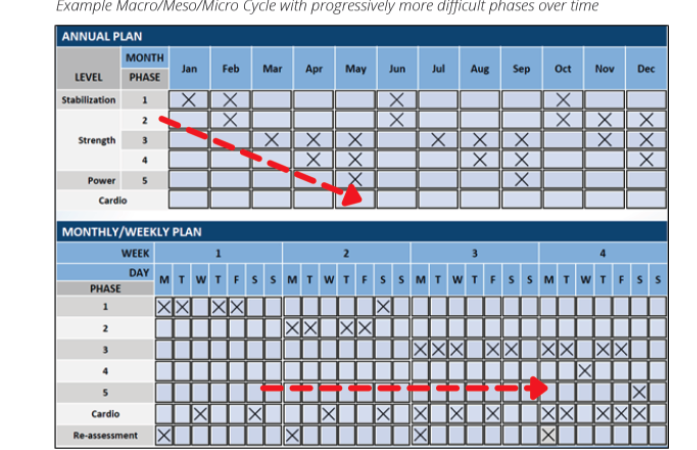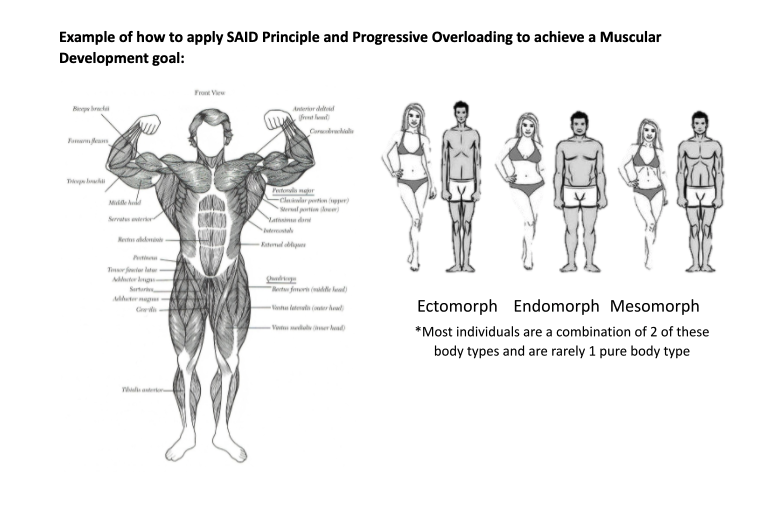Blog
SAID Principle
How to Leverage Progressive Overloading for Muscular Development
Do you spend hours each week in the gym but feel like you’re not seeing it really pay off? Whether your objective is to set a new PR or to achieve a physique goal, leveraging the Specific Adaptations to Imposed Demands (SAID) Principle and Progressive Overloading will help you break through plateaus and accelerate your growth. 8X Mr. Olympia Ronnie Coleman once said, “Everybody wanna be a bodybuilder, but don’t nobody wanna lift no heavy ass weight!”
Ronnie knew exactly what progressive overloading meant (to the max!) which is what it took to impose enough stress on his physique to create the necessary adaptations to be the strongest Mr. Olympia ever.
In this blog, we will focus on driving hypertrophy for muscular development by leveraging these mechanisms as part of your training regimen.
Specific Adaptation to Imposed Demands (SAID) Principle states that adaptations are specific to the imposed stimulus. General Adaptation Syndrome (GAS) by Hans Selye describes the pattern of responses that the body goes through after being prompted by a stressor.
Characteristics of SAID Principle:
Force specific musculoskeletal adaptations to imposed stress
Avoid the potential of plateauing to keep client progressing
Based on the principle of general adaptation syndrome
Overlaps with the concept of progressive overloading
Different tissue requires different stimulus
Increasing intensity requires increased stabilization and mobility
Prioritize and pre-exhaust lagging muscle groups first
Train weak areas 10-15% more
Specific Adaptation to Imposed Demands (SAID) Principle states that adaptations are specific to the imposed stimulus. This technique allows you to target specific musculoskeletal areas and craft a plan to develop them (i.e. Improvements to lagging muscle groups, kinetic chain inefficiencies, symmetry, proportions, etc.).
Progressive Overloading forces specific adaptations on the muscles due to an increase in stress/demand over time.
The Principle of Progression states that increases in time, weight, or intensity should be kept within 10% or less each week to allow for a gradual adaptation while minimizing the risk of injury. Without this progressive overloading, muscle growth will plateau. In fact, a decrease in loading over an extended period of time can actually cause muscle atrophy - a loss in skeletal muscle size and strength.
With consistent training, the body will adapt to the progressions and meet the demands of the stress placed upon it. You can leverage the muscle-tension variable by increasing the load and causing an adaptation in the force output of the muscle over time. It may also be helpful to pyramid up in weight during a workout (or week over week) to activate as much Type 2a fast-twitch muscle fiber as possible. The more total muscle fiber you can recruit, the greater the demand and resulting response on the muscle.
There are many different ways to achieve progressive overloading that you may already be doing today. For example, have you ever been in the gym for a set of squats and found yourself pyramiding up in weight each set? Or maybe you're doing a single-leg exercise and decide to step it up a notch by standing on a foam pad or bosu ball? These are in fact great examples of progressive overloading on a micro scale. These types of progressions can be integrated into your regimen within a workout, weekly/monthly, or yearly basis.
Another benefit is that Progressive Overloading allows you to train within the same NASM OPT phase without hitting a plateau by increasing the stimulus and demand placed on the muscle over an extended period of time. This means you can primarily train in the Hypertrophy/Muscular Development Strength phase for several months without hitting a plateau by utilizing SAID and Overload principles in your weekly/monthly training cycles (micro/meso cycles).
Mechanisms for Hypertrophy & Muscular Development…The Science Inside the Muscle
1) Exercise-Induced Muscle Damage
During eccentric activity, the contractile elements (actin and myosin) in working muscles exert a resistance action that produces small tears in both the contractile elements and surface membrane (sarcolemma) of the associated muscle fibers. The subsequent muscle repair strengthens the tissue to protect against further damage (adaptation).
2) Metabolic Stress
Metabolic stress results from the buildup of various metabolites (e.g., lactic acid, inorganic phosphate, etc.), primarily as a result of training in the fast glycolytic energy system where carbohydrates are used anaerobically to fuel performance.
3) Mechanical Tension (force)
Refers to the amount of force developed by muscle fibers in response to a static or dynamic stimulus. The reaction increases protein synthesis and muscle size. The goal is to activate as many muscle fibers as possible to maximize the result.
4) Fascia Stretch Training
Pumping specific muscle groups full of oxygenated blood in a relatively short period of time, forcing the fascia tissue to stretch and expand like a balloon. This packs nutrient and oxygen-rich blood into and around the muscle cells to promote repair and growth.
We must also consider the mind-muscle connection to drive the recruitment of more muscle fiber to maximize the response.
The National Academy of Sports Medicine (2018) defines Hypertrophy as "the enlargement of skeletal muscle fibers in response to being recruited to develop increased levels of tension, as seen in resistance training. [It] is characterized by an increase in the cross-sectional area of individual muscle fibers resulting from an increase in myofibril proteins(myofilaments).
What are the Acute Training Variables that Drive Muscular Development?
Variables and considerations for developing your physique:
Timing/Cadence (Concentric vs Eccentric)
Force, loading (i.e. %1RM)
Rest intervals between sets
Horizontal vs Vertical loading
Volume of reps and sets
Time under tension
Training frequency, distance, or duration
Exercise selection & variety, bilateral vs unilateral exercise
Distal joint position: Open-Kinetic Chain vs Closed-Kinetic Chain training
The training split and prioritization of specific muscle groups
If you’re wondering why these acute variables are important in hypertrophy training for bodybuilding, they determine the amount of stress placed on the body and, ultimately, what adaptations the body will incur. This can be customized to specific adaptations used for bodybuilding and physique goals as you also work on improving overall body composition.
The advantages of bilateral training for bodybuilding and physique goals are improved symmetry and elimination of lagging left-to-right muscle groups.
Pro Tip: Hypertrophy/Muscular Development training is typically moderate-heavy loading (75-85% 1RM), 8-12 reps, 2-0-2, 0-60 or 0-30 rests, 3-5 sets (up to 7), 2-4 Strength exercises per body part

Meso Cycle Weeks 1-4:
1) Example of flexibility & stabilization phase with light cardio early in prep (beginner)
2) Example of Intermediate phase with strength endurance to prepare joints and prime movers for subsequent training intensity
3) Hypertrophy phase for maximizing muscle growth. Increased cardio to improve body composition. (Medium/Advanced)
4) Advanced microcycle grounded in hypertrophy/strength/power during prep. Increased cardio to facilitate body comp goals
For more information on Resistance Training check out parts 1 & 2 of the Fundamentals of Resistance Training series!

If the left arm is asymmetrical and smaller than the right arm (lagging), we can address this with SAID Principle and Progressive overloading to help correct and balance the physique over a period of time. We can identify these lagging groups visually, by circumference measurements, or maybe you notice a difference in strength from one side to the other. To create the desired adaptation, we need to impose a stimulus on the lagging muscle group. You can start by pre-exhausting this area with 2-3 light sets of stabilization exercises to activate more muscle fiber prior to subsequent working sets. In this scenario, since the goal is to improve left to right symmetry, I would recommend training unilateral exercises to isolate each arm. 2-3 sets of bicep curls and triceps extensions with a band or cable would be a great way to pre-exhaust your lagging side prior to any bilateral or compound movements. Additionally, the total demand and volume placed on the lagging area should be 10-20% greater than the imposed stimulus on the rest of the muscles to force a specific adaptation to occur. In bodybuilding, we call this the Principle of Prioritization.
This technique allows you to target specific musculoskeletal areas and craft a plan to develop them (i.e. Improvements to lagging muscle groups, kinetic chain inefficiencies, symmetry, proportions, etc.).
Applying SAID Principle Plus Training Considerations by Body Type
Ectomorph
Train heavy, longer rests between sets, less cardio, more compound CKC lifts to recruit max muscle. 14-16 heavier sets per body part typical. Higher percent carb intake 50-60% over 5-7 meals/day especially around workouts, more aggressive calories to gain muscle
Endomorph
Moderate weights, shorter rests between sets, more aerobic cardio, a mix of compound lifts and single-joint lifts to maximize calorie burn. Train with higher set/rep volumes. PHA is also great. Lower % carbs 20-30% and less aggressive calories during a bulk. Greater deficit to cut.
Mesomorph
Ideal for Phase 3 Muscular Development/Hypertrophy training principles. Emphasis on more advanced training splits for aesthetic goals to build physique proportionally. 16-20 sets per body part typical. A balanced diet with 40-50% carbs, higher % protein, and moderate/low fats spread out over 5-6 meals.

About the author Andre Adams
With over 15 years of experience, Andre Adams is a National Academy of Sports Medicine (NASM) Master Trainer with credentials in women's fitness specialist (WFS), performance enhancement specialist (PES), mental toughness (MT), weight loss specialist (WLS), Group Personal Training Specialist (PTS), and fitness nutrition specialist (FNS). Additionally, he offers advice to help curb childhood obesity in adolescents.
Andre is also a professional athlete in the International Federation of Bodybuilding (IFBB) pro league having competed in the 2015 Mr. Olympia and Arnold Classic professional physique divisions.

153 Comments